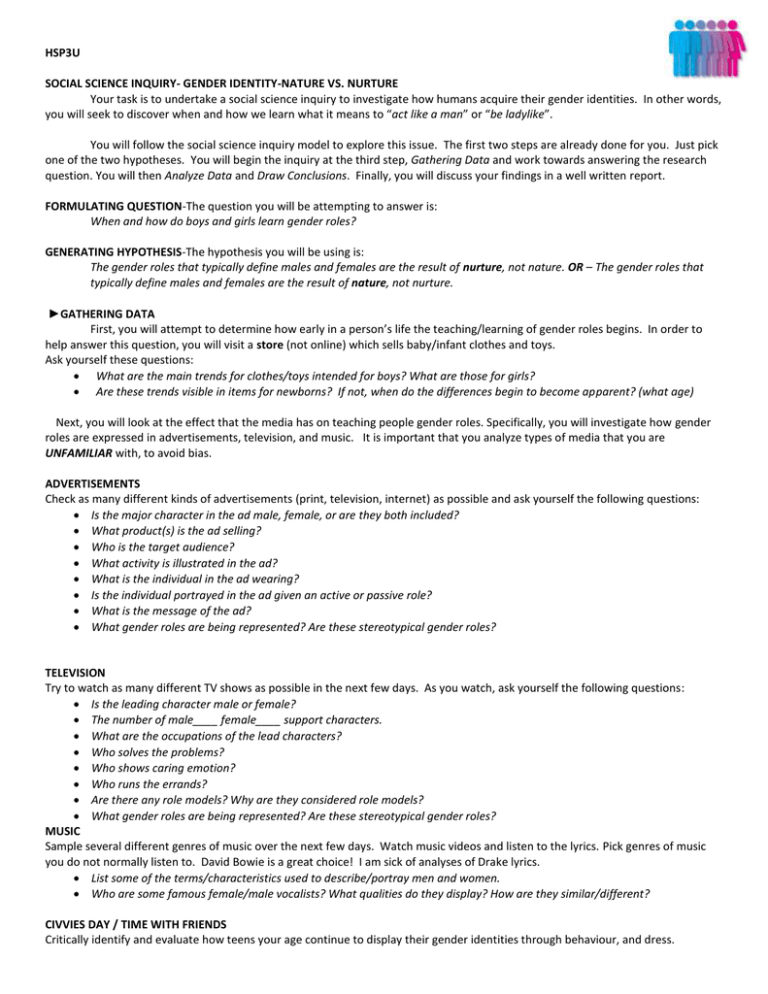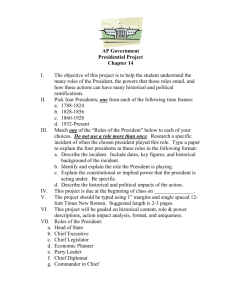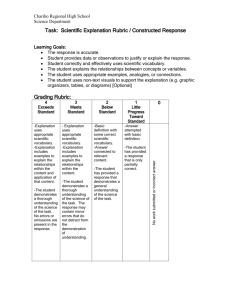HSP3U SOCIAL SCIENCE INQUIRY- GENDER IDENTITY-NATURE VS. NURTURE
advertisement

HSP3U SOCIAL SCIENCE INQUIRY- GENDER IDENTITY-NATURE VS. NURTURE Your task is to undertake a social science inquiry to investigate how humans acquire their gender identities. In other words, you will seek to discover when and how we learn what it means to “act like a man” or “be ladylike”. You will follow the social science inquiry model to explore this issue. The first two steps are already done for you. Just pick one of the two hypotheses. You will begin the inquiry at the third step, Gathering Data and work towards answering the research question. You will then Analyze Data and Draw Conclusions. Finally, you will discuss your findings in a well written report. FORMULATING QUESTION-The question you will be attempting to answer is: When and how do boys and girls learn gender roles? GENERATING HYPOTHESIS-The hypothesis you will be using is: The gender roles that typically define males and females are the result of nurture, not nature. OR – The gender roles that typically define males and females are the result of nature, not nurture. ►GATHERING DATA First, you will attempt to determine how early in a person’s life the teaching/learning of gender roles begins. In order to help answer this question, you will visit a store (not online) which sells baby/infant clothes and toys. Ask yourself these questions: What are the main trends for clothes/toys intended for boys? What are those for girls? Are these trends visible in items for newborns? If not, when do the differences begin to become apparent? (what age) Next, you will look at the effect that the media has on teaching people gender roles. Specifically, you will investigate how gender roles are expressed in advertisements, television, and music. It is important that you analyze types of media that you are UNFAMILIAR with, to avoid bias. ADVERTISEMENTS Check as many different kinds of advertisements (print, television, internet) as possible and ask yourself the following questions: Is the major character in the ad male, female, or are they both included? What product(s) is the ad selling? Who is the target audience? What activity is illustrated in the ad? What is the individual in the ad wearing? Is the individual portrayed in the ad given an active or passive role? What is the message of the ad? What gender roles are being represented? Are these stereotypical gender roles? TELEVISION Try to watch as many different TV shows as possible in the next few days. As you watch, ask yourself the following questions: Is the leading character male or female? The number of male____ female____ support characters. What are the occupations of the lead characters? Who solves the problems? Who shows caring emotion? Who runs the errands? Are there any role models? Why are they considered role models? What gender roles are being represented? Are these stereotypical gender roles? MUSIC Sample several different genres of music over the next few days. Watch music videos and listen to the lyrics. Pick genres of music you do not normally listen to. David Bowie is a great choice! I am sick of analyses of Drake lyrics. List some of the terms/characteristics used to describe/portray men and women. Who are some famous female/male vocalists? What qualities do they display? How are they similar/different? CIVVIES DAY / TIME WITH FRIENDS Critically identify and evaluate how teens your age continue to display their gender identities through behaviour, and dress. How does a teenage girl /boy behave? How do they dress when not in the Roch uniform? Is their dress and behaviour influenced by popular culture as well as gender identity? ►ANALYZING DATA & DRAWING CONCLUSIONS Once you have collected enough raw data you will carefully analyze it then draw your conclusions. When does the process of socialization begin to take place? Is one source more influential than others in this process? Are there any trends that appear? Is one’s gender identity challenged? If so, at what age? ►PRESENTING YOUR FINDINGS The final step in this assignment is to present your findings. Your report will consist of: An Introduction A summary of your research (how you gathered data) Conclusions-Answer the research question: When and how do boys and girls learn gender roles? Guiding Questions: How early do children learn gender roles? Who is responsible for teaching gender roles? How does this happen? A Conclusion Specifications: Minimum 3 pages in length – that is BARE work. And I mean bare = minimal. Must be word processed 11-size font in Calibri Do not adjust margins GENDER IDENTITY ASSIGNMENT-RUBRIC CRITERIA Quality of Information KNOWLEDGE Organization COMMUNICATION Analysis of Evidence THINKING Writing Mechanics APPLICATION LEVEL 1 5-5.9 -Displays limited amount of the content required -Limited amount of research, detail, examples. -Content is presented in a sequence that demonstrates limited planning and sense of purpose. -Ideas and information are presented with limited effectiveness. LEVEL 2 6-6.9 -Displays some of the content required. -Some evidence of research, detail, examples LEVEL 3 7-7.9 -Displays considerable amount of the content required. -Considerable research, detail, and examples. LEVEL 4 8-10 -Contains all of the content required. -Thorough research, detail, and examples. -Content is presented in a sequence that demonstrates some planning and sense of purpose. -Ideas and information are presented with some effectiveness. -Content is presented in a sequence that demonstrates considerable planning and sense of purpose. -Ideas and information are presented with considerable effectiveness. -Content is presented in a sequence that demonstrates excellent planning and sense of purpose. -Ideas and information are presented with a high degree of effectiveness. -Limited focus on topic. -Limited explanation or analysis of relationships. -Some focus on topic. -Explanation or analysis of relationships shows some logic and insight. -There are several minor errors or omissions. -Some mechanical errors. -Considerably effective in focusing on topic. -Explanation or analysis of relationships shows considerable logic and insight. -There are only a few minor errors or omissions. -Some mechanical errors. -Highly effective in focusing on topic. -Analysis of relationships shows high degree of logic and insight. -There are practically no errors or omissions. -Mechanical error free. -There are several major errors or omissions. -Numerous mechanical errors. GRADE /30 /25 /30 /15

